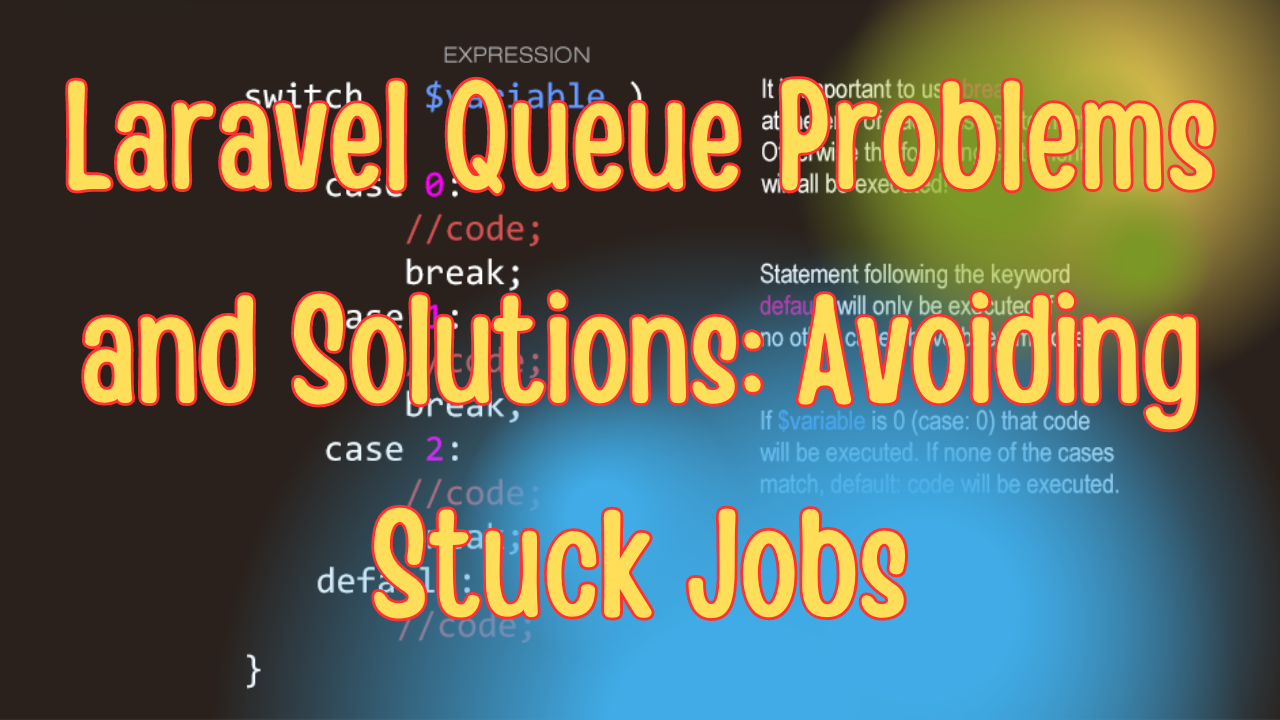Queues in Laravel are a powerful tool for deferring time-consuming tasks like sending emails, processing uploads, or generating reports. However, queues can sometimes run into problems like jobs getting stuck, not executing, or even disappearing without any trace. In this article, we'll explore common issues with Laravel queues, their causes, and provide practical solutions with detailed code examples.
Understanding the Laravel Queue Workflow
Before diving into solutions, let’s briefly understand how Laravel queues work:
-
Queue Configuration: Laravel supports multiple queue drivers like
database,redis,sqs, etc. You configure your queue driver in the.envfile:QUEUE_CONNECTION=redis -
Dispatching Jobs: You can dispatch jobs using
dispatch()or by pushing them directly to a specific queue:SomeJob::dispatch($data); -
Workers: The queue workers process these jobs. You can start a worker using:
php artisan queue:work -
Supervisors: In production, a process manager like Supervisor is used to keep the workers running continuously.
Common Queue Issues and Solutions
1. Jobs Stuck in Pending
Problem:
Jobs can get stuck in a pending state and never get executed. This usually happens when the queue worker isn’t running or is misconfigured.
Solution:
Make sure the worker is running by executing:
php artisan queue:work
For a production environment, it’s better to use queue:work with a process manager like Supervisor. Here’s a basic configuration for Supervisor:
[program:laravel-queue-worker]
process_name=%(program_name)s_%(process_num)02d
command=php /path-to-your-app/artisan queue:work --sleep=3 --tries=3 --timeout=90
autostart=true
autorestart=true
numprocs=3
redirect_stderr=true
stdout_logfile=/path-to-your-app/worker.log
Tip: If you notice jobs getting stuck after a server restart or deployment, consider running php artisan queue:restart to signal workers to gracefully restart and pick up new code changes.
2. Jobs Fail and Get Stuck in the Failed Jobs Table
Problem:
When jobs fail due to exceptions, they get stored in the failed_jobs table (if configured), which can leave your application in an unexpected state.
Solution:
First, configure the failed_jobs table by running:
php artisan queue:failed-table
php artisan migrate
You can manually retry failed jobs using:
php artisan queue:retry all
Or if you want to retry a specific job:
php artisan queue:retry --id=12345
To handle failures more gracefully, implement a failed() method within your job class:
public function failed(\Exception $exception)
{
// Send notification to admins, log the issue, etc.
Log::error("Job failed with exception: " . $exception->getMessage());
}
3. Memory Leaks and Exhaustion
Problem:
Workers can hit memory limits if a job consumes too much memory, causing subsequent jobs to get stuck.
Solution:
You can specify a memory limit when starting the worker:
php artisan queue:work --memory=128
Additionally, monitor your jobs for memory usage and break them into smaller chunks if possible.
4. Long-Running Jobs and Timeouts
Problem:
Jobs that run for too long can hit the timeout limit, leading to premature termination.
Solution:
First, ensure the job’s timeout is properly set:
php artisan queue:work --timeout=120
You can also set a custom timeout within the job class:
public $timeout = 120;
If a job is expected to take longer than usual, consider breaking it into smaller jobs and chaining them:
ChainJobs::withChain([
new FirstPartOfTheJob(),
new SecondPartOfTheJob(),
])->dispatch();
5. Jobs Getting Stuck When Using Redis
Problem:
When using Redis as your queue driver, you might encounter jobs getting stuck due to connection issues or Redis failing to process the jobs.
Solution:
-
Monitor Redis Connection: Ensure your Redis server is properly monitored and configured. You can use tools like
redis-clito check the health. -
Redis Configuration in Laravel: Check your Redis configuration in
config/database.php:'redis' => [ 'client' => env('REDIS_CLIENT', 'phpredis'), // or 'predis' 'options' => [ 'cluster' => env('REDIS_CLUSTER', 'redis'), 'prefix' => env('REDIS_PREFIX', Str::slug(env('APP_NAME', 'laravel'), '_').'_database_'), ], ... ] -
Resetting the Queue: If Redis queues become stuck, you can reset the queue by purging it:
php artisan queue:flush
6. Jobs Disappearing from the Queue
Problem:
In some cases, jobs can disappear from the queue without being processed, especially when they’re popped off the queue but the worker crashes before processing.
Solution:
-
Use
queue:retryas shown earlier to push failed jobs back onto the queue. -
Optimize Job Execution: Ensure your job logic is robust and handles exceptions gracefully. For example, wrapping the main logic in a try-catch block can help:
public function handle() { try { // Job logic here } catch (\Exception $e) { $this->fail($e); // Mark the job as failed } } -
Monitor and Alert: Use monitoring tools like Laravel Horizon (if using Redis) or external services like Sentry to monitor job execution and get alerts when something goes wrong.
7. Inefficient Job Processing Leading to Queue Backlogs
Problem:
If your jobs are taking too long or if there are too many jobs, you may end up with a backlog, causing delays.
Solution:
-
Optimize Your Jobs: Break down large jobs into smaller tasks that can be handled faster.
-
Scale Your Workers: Increase the number of workers processing the queue:
php artisan queue:work --workers=5 -
Batch Processing: Use Laravel’s built-in batch processing feature to handle related jobs together:
Bus::batch([ new ProcessJobOne(), new ProcessJobTwo(), ])->dispatch(); -
Use Queues for Priority Jobs: Configure multiple queues for high-priority and low-priority jobs:
SomeJob::dispatch()->onQueue('high');
You can then start workers dedicated to high-priority queues:
php artisan queue:work --queue=high
Conclusion
Managing Laravel queues effectively is crucial for building scalable and reliable applications. By addressing common issues like stuck jobs, memory leaks, and inefficient processing, you can ensure smooth and consistent performance. Properly configuring your environment, optimizing your jobs, and implementing graceful error handling will save you a lot of headaches in the long run.
By following these best practices and solutions, you’ll avoid many of the common pitfalls associated with Laravel queues and keep your jobs running smoothly!




